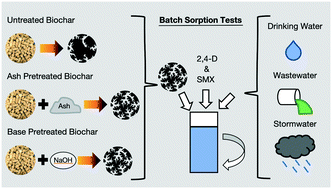当前位置:
X-MOL 学术
›
Environ. Sci.: Water Res. Technol.
›
论文详情
Our official English website, www.x-mol.net, welcomes your feedback! (Note: you will need to create a separate account there.)
Ash pretreatment of pine and biosolids produces biochars with enhanced capacity for organic micropollutant removal from surface water, wastewater, and stormwater
Environmental Science: Water Research & Technology ( IF 5 ) Pub Date : 2019/12/17 , DOI: 10.1039/c9ew00862d Matthew J Bentley 1, 2, 3, 4 , R Scott Summers 1, 2, 3, 4
Environmental Science: Water Research & Technology ( IF 5 ) Pub Date : 2019/12/17 , DOI: 10.1039/c9ew00862d Matthew J Bentley 1, 2, 3, 4 , R Scott Summers 1, 2, 3, 4
Affiliation

|
An ash pretreatment process was developed and evaluated for improving sorption of 2,4-dichlorophenoxyacetic acid (2,4-D) and sulfamethoxazole (SMX) for pine and biosolids based biochars. Pine and biosolids pellets were soaked in a dissolved ash solution and pyrolized at 800 °C. The sorption performance of untreated pine biochar, pine ash pretreated biochar, untreated biosolids biochar, biosolids ash pretreated biochar, base pretreated pine biochar, and commercial powdered activated carbon (PAC) was compared in deionized water, lake water, wastewater, and stormwater for 2,4-D and SMX removal. Dose response curves were developed at 3 hour and 7 day contact times in continuously mixed batch tests. Ash pretreatment of pine yielded over an order of magnitude increase in 2,4-D and SMX sorption compared to untreated pine biochar, making it competitive with PAC. Base pretreatment was the dominant improvement process of ash pretreatment, and the improvement from ash pretreatment was linked to the precursor feedstock inherent ash content. Adsorbent performance was strongly correlated with non-micropore (>2 nm) surface area. Background organic matter character significantly impacted sorbent performance. Ash pretreatment of biochar increased organic micropollutant sorption and is applicable in low-cost water treatment scenarios, such as stormwater and wastewater treatment, as well as in low- and middle-income countries.
中文翻译:

松树和生物固体的灰分预处理产生的生物炭具有增强的能力,可从地表水,废水和雨水中去除有机微污染物
开发了灰分预处理工艺,并对其进行了评估,以改善2,4-二氯苯氧基乙酸(2,4-D)和磺胺甲恶唑(SMX)对松树和生物固体生物炭的吸附。将松木和生物固体小球浸泡在溶解的灰溶液中,并在800°C下热解。比较了在去离子水,湖水,废水和雨水中,未经处理的松木生物炭,松灰预处理的生物炭,未经处理的生物固体生物炭,生物固体灰分预处理的生物炭,基础预处理的松木生物炭和商业粉状活性炭(PAC)的吸附性能2 ,4-D和SMX去除。在连续混合批次测试中,在3小时和7天的接触时间处绘制出剂量反应曲线。与未经处理的松木生物炭相比,对松木进行灰烬预处理可使2,4-D和SMX吸附量增加一个数量级,与PAC竞争。基础预处理是灰分预处理的主要改进过程,灰分预处理的改进与前体原料固有的灰分含量相关。吸附性能与非微孔(> 2 nm)表面积密切相关。背景有机物的特性极大地影响了吸附剂的性能。生物炭的灰分预处理提高了有机微污染物的吸附能力,适用于低成本水处理方案,例如雨水和废水处理,以及中低收入国家。2 nm)表面积。背景有机物的特性极大地影响了吸附剂的性能。生物炭的灰分预处理提高了有机微污染物的吸附能力,适用于低成本水处理方案,例如雨水和废水处理,以及中低收入国家。2 nm)表面积。背景有机物的特性极大地影响了吸附剂的性能。生物炭的灰分预处理提高了有机微污染物的吸附能力,适用于低成本水处理方案,例如雨水和废水处理,以及中低收入国家。
更新日期:2020-03-05
中文翻译:

松树和生物固体的灰分预处理产生的生物炭具有增强的能力,可从地表水,废水和雨水中去除有机微污染物
开发了灰分预处理工艺,并对其进行了评估,以改善2,4-二氯苯氧基乙酸(2,4-D)和磺胺甲恶唑(SMX)对松树和生物固体生物炭的吸附。将松木和生物固体小球浸泡在溶解的灰溶液中,并在800°C下热解。比较了在去离子水,湖水,废水和雨水中,未经处理的松木生物炭,松灰预处理的生物炭,未经处理的生物固体生物炭,生物固体灰分预处理的生物炭,基础预处理的松木生物炭和商业粉状活性炭(PAC)的吸附性能2 ,4-D和SMX去除。在连续混合批次测试中,在3小时和7天的接触时间处绘制出剂量反应曲线。与未经处理的松木生物炭相比,对松木进行灰烬预处理可使2,4-D和SMX吸附量增加一个数量级,与PAC竞争。基础预处理是灰分预处理的主要改进过程,灰分预处理的改进与前体原料固有的灰分含量相关。吸附性能与非微孔(> 2 nm)表面积密切相关。背景有机物的特性极大地影响了吸附剂的性能。生物炭的灰分预处理提高了有机微污染物的吸附能力,适用于低成本水处理方案,例如雨水和废水处理,以及中低收入国家。2 nm)表面积。背景有机物的特性极大地影响了吸附剂的性能。生物炭的灰分预处理提高了有机微污染物的吸附能力,适用于低成本水处理方案,例如雨水和废水处理,以及中低收入国家。2 nm)表面积。背景有机物的特性极大地影响了吸附剂的性能。生物炭的灰分预处理提高了有机微污染物的吸附能力,适用于低成本水处理方案,例如雨水和废水处理,以及中低收入国家。



























 京公网安备 11010802027423号
京公网安备 11010802027423号